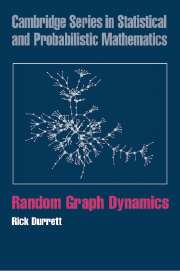4 - Power Laws
Published online by Cambridge University Press: 18 August 2009
Summary
Barabási–Albert Model
As we have noted, many real-world graphs have power law degree distributions. Barabási and Albert (1999) introduced a simple model that produces such graphs. They start with a graph with
a small number of vertices m0. At every time step, we add a new vertex with m edges that link the new vertex to m different vertices already present in the system. To incorporate preferential attachment, we assume that the probability Π that a new vertex will be connected to a vertex i depends on the connectivity of that vertex, so that Π(ki) = ki/Σjkj. After t steps the model leads to a random network with t + m0 vertices and mt edges.
Bollobás, Riordan, Spencer, and Tusnády (2001) complain: “The description of the random graph process quoted above is rather imprecise. First as the degrees are initially zero, it is not clear how the process is supposed to get started. More seriously, the expected number of edges linking a new vertex to earlier vertices is ΣiΠ(ki) = 1, rather than m. Also when choosing in one go a set S of m earlier vertices as neighbors of v, the distribution is not specified by giving the marginal probability that each vertex lies in S.”
As we will see below there are several ways to make the process precise and all of them lead to the same asymptotic behavior.
- Type
- Chapter
- Information
- Random Graph Dynamics , pp. 90 - 131Publisher: Cambridge University PressPrint publication year: 2006



